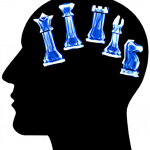Training chess |
Here are our resources for chess training. Click on the pertinent section in order to access the content: tactics, strategy, endgames, openings. You can also go directly into the posts of your interest. On the left, you can explore our categories; on the right you will see our most recent publications. Each section is dedicated to one aspect of chess training. Enjoy your practice!
Improve your tactical abilities and your vision for chess combinations. In this section, you will find resources for chess tactics training: explanations, exercises, classified puzzles... Tactics are the basis of chess thinking. They consist of the classification of patterns of attack and defense in chess. In other words, tactics consist of the analysis of possibilities for the execution of strategical objectives. For this reason, tactics are the most fundamental aspect of chess.
Chess training! Tactics
No sub-categories
Improve your strategy and your positional understanding of chess. Here you will find didactic materials that will help you perfect your intuition, your handling of typical positions and pawn structures, and your planning and execution skills. Strategy is the most complex aspect of chess and the most difficult to study. However, strategical insight is one of the trademarks of the good chess player.
In this section you will be able to practice chess endgames. These are positions in which very few pieces are left on the board. Consequently, endgames are the perfect tool for learning chess tactical and strategical concepts. Moreover, studying endgames helps you master the movements and possibilities of each piece. On top of that, endgames have a great practical value, since many of the endgame methods apply to many positions.
Study and practice openings with the most informative materials: master analyses, model games, opening repertoires... The opening consists of the initial moves of the game. We provide you with advice on how to study and train openings so that you can save time and improve your efficiency. The opening is the most heavily studied phase of the game of chess, and therefore is one of the easiest to learn. For this reason, they are an endless resource of didactic ideas. Learning openings helps you classify and memorize tactical and strategical patterns, improving your general understanding of the game.
Quick guide for chess training
1. Diversify your training
Our minds get used to repetitive stimuli. Do not limit yourself to a particular kind of training. Like in any other sport, proper chess training requires variety. Work on every aspect of chess mastery. In addition, you should try different training methods and systems.
2. Practice with high intensity
Training chess in a passive way is not very productive. You must make training as similar as possible to a real competitive game. Try to find good moves on your own before you look them up. Set objectives and perform at least one part of your training under time pressure.
3. Solve tactic puzzles
Tactics are the basis of chess. They constitute the simplest logical patterns of attack and defense in chess. Mastering tactics is necessary for any deeper chess understanding. Solve chess tactic puzzles regularly. Resuelve problemas de táctica ajedrecística regularmente.
4. Hone your endgame skills
Similarly to tactics, endgames contain the essence of chess, due to their simplicity of elements. All the great players in chess history were excellent endgame players. Learn endgames and practice your endgame technique.
5. Build an opening repertoire
An opening repertoire is a prepared response to any reasonable move our opponents may do in the opening. Playing exclusive openings allows you to master them better and to delve deeper into them. This way, you will be able to focus on middle game positions and more general aspects of the game of chess.
6. Play focused practice games
Playing games is probably the most important chess training method of all. However, you shouldn't play aimlessly if you want to improve your skill. Play with high focus and intensity, never to exhaustion. Use these games to practice your opening repertoire.
7. Do calculation exercises
This is particularly important for the 'classical' modality of chess (slow time controls). The idea is to improve your thinking process and your reasoning. There are difference methods to accomplish this. You may try to solve hard puzzles or simply analyze complicated positions in your head (without moving the pieces on the board).
8. Practice 'blindfold' chess.
As you advance in your progress, you will aquire new abilities. Among other things, you will be able to play without looking at the board. Practicing this ability is a very productive chess training. It helps you visualize the pieces in your mind and it exercises your working memory. In addition, it will help you be more conscious of all your pieces.
9. Be consistent and persevere.
Chess is an ability that depends on long term memory for thousands of previously learnt patterns. Great dedication is required to reach significant progress. There are no tricks, formulas or miracle shortcuts. If you want to get good results, you must train chess regularly and persistently. And of course, enjoy the process!

